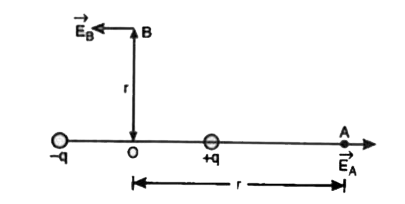A and B are two points on the axis and perpendicular bisector respectively of an electric dipole. A and B are far away from dipole and at equal distances from it. If fields at A and B −→EAand−→EA are then :
−→EA=−→EB
−→EA=2−→EB
∣∣∣−→EA∣∣∣=12∣∣→EB∣∣,&−→EB⊥−→EA
−→EA=−2−→EB
The correct Answer is:D
EP=14πε0pr3√3cos2θ+1

On axial line ,
−→EA=14πε0→pr3×2 [∴cosθ=cos0∘=1]
& −→EB=14πε0→pr3(−ve) (as direction of EB is opposite to −→EA )
∴−→EA=−2−→EB
Topper's Solved these Questions
- ELECTROSTATICSBOOK - MODERN PUBLICATIONCHAPTER - ELECTROSTATICSEXERCISE - LEVEL -II
74 Videos
- ELECTROSTATICSBOOK - MODERN PUBLICATIONCHAPTER - ELECTROSTATICSEXERCISE - LEVEL-III
23 Videos
- ELECTRONS & PHOTONSBOOK - MODERN PUBLICATIONCHAPTER - ELECTRONS & PHOTONSEXERCISE - RECENT COMPETITIVE QUESTIONS
20 Videos
- GRAVITATIONBOOK - MODERN PUBLICATIONCHAPTER - GRAVITATIONEXERCISE - Recent Competitive Questions
8 Videos
Similar Questions
A and B are two points on the axis and the perpendicular bisector, reapectively, of and electric dipole. A and B are far away from the dipole and at equal distance from it. The fields at A and B are →EA and →EB. Then
View SolutionThe electric field of an electric dipole at a point on its axis , at a distance d from the centre of the dipole, varies as
View Solution
Knowledge Check
A and B are two points on the axis and the perpendicular bisector, reapectively, of and electric dipole. A and B are far away from the dipole and at equal distance from it. The fields at A and B are →EA and →EB. Then
A→EA=→EBB→EA=2→EBC→EA=−2→EBD∣∣∣→EB=12∣∣∣→EA∣∣∣, and →EA is perpendicular to →EB.A and B are two points on the axis and the perpendicular bisector of an electric dipole. A and B are far away from the dipole and at equal distances from it. The potentials at A and B are VAandVB respectively. Then
AVA=VB=0BVA=2VBCVA≠0,VB=0DVA≠0,VB≠0P and Q are two points on the axis and the perpendicular bisector respectively of an electric dipole. Both the points are far way from the dipole, and at equal distances from it. If →EP and →EQ are fields at P and Q ten
A→EP=→EQB→EP=−2→EQC→EP=2→EQD∣∣∣EQ=12∣∣∣EP∣∣∣, and →EQ is perpendicular to →EP
A point Q lies on the perpendicular bisector of an electrical dipole of dipole moment p, If the distance of Q from the dipole is r (much larger than the size of the dipole), then electric field at Q is proportional to
View SolutionOn the perpendicular bisector of an electric dipole, electric intensity E and potential V are
View SolutionA point P lies on the perpendicular bisector of a short electric dipole, of dipole moment p' at a distance r from the centre of dipole. The electric field at point P is proportional to
View SolutionThe electric field of an electric dipole at a point on its axis , at a distance d from the center of the dipole, varies as
View SolutionA point Q lies on the perpendicular bisector of an electrical dipole of dipole moment p. If the distance of Q from the dipole is r (much larger than the size of the dipole), then electric field at Q is proportional to
View Solution
